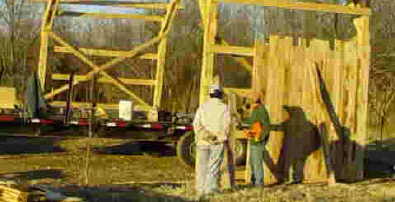Entering the Cut
Bandmill operators discuss the problem of a brief "bump" in blade tracking as the blade first enters the log. Usually, blade tension is the issue. October 14, 2006
Question
I have a well-used 1985 LT40. I cut Douglas fir and pine and have come to learn that sharp blades are the answer to almost every problem. But I still find that the cut has a bump at the beginning, even if the rest is straight and level. Am I entering too fast, too slowly, too much or not enough blade tension, or using the wrong blades? Any advice would be appreciated.
Forum Responses
(Sawing and Drying Forum)
From contributor A:
Check your drive belt tension.
From contributor B:
Check your main drive belt tension. If thatís not the problem, check to make sure your guides are in good order and adjusted correctly. Also, you could be using a blade thatís not set right. That is, it may have more set on one side than the other. Check your blade tracking. Too far back on the guides and youíll start pushing the blade with the shoulder of the guide. Too far forward and the blade wonít be supported. Iíve noted blade climb sometimes when Iíve had a blade thatís got gunk built up on the teeth on the bottom side.
From contributor C:
I have the same affliction milling with a similar mill. While it makes the ends of the stack look less uniform, this material will end up as trim so I have not devoted a lot of time to preventing it. Sharp blades and tension are factors but not a sure cure. Does anyone have anecdotal discussion about milling from the bottom up or the top down? I have not been able to quantify it but it seems like I get the most "dance" when entering the butt portion first. This shows up on cants and second logs so I wonder if it is a grain pattern effect. There would not be a way to predict this. If I see it I check the blade tension and sharpness and keep milling.
From contributor D:
I am not a bandmill person, but I have seen a discussion on cutting top to bottom (butt last) and the consensus is that it is easier on blade tracking. On my circle mill, I cut without regard to butt or taper first with no change that I can see.
From contributor E:
It is band tension or drive belt tension. I was having the bump issue a while back when milling hardwoods. I swapped out the drive belt and still had a hump. My blade manufacturer's guide book gives a list of things to check - band tension being one of the many. After checking the band tension I was well under maximum specification for the .042 1.25" I run. Increasing band tension eliminated the hump 100%.
From contributor F:
Check out troubleshooting with Suffolk Machinery. I've had this problem sawing white oak. They suggest sharpening to a reduced hook angle to correct this problem. It worked for me - sharpen to 8 degrees.
From Dr. Gene Wengert, technical advisor, Sawing and Drying Forum:
A blade will want to follow the grain and will also tend to go where there is less material to cut (toward the bark). We control the direction by using a lot of tension. Regarding butt end or top end first, if full taper (cutting parallel to the bark) is not used, when cutting from the butt end the blade will want to follow the grain and will tend to move toward the bark until the tension or guides limit that movement. The advantage of starting at the butt when not sawing parallel to the bark is that you can saw short pieces of lumber. If you start at the top, the blade will be in the air and then when it starts to contact the log will initially try to avoid going into the log. Once in the log, it will try to follow the grain, etc. As mentioned several times in earlier postings, tension is the way we direct the blade to follow the path that we want. Note that the blade in a circular mill is set into the log a little bit (called lead). I do not recall that band blades have lead, mainly because it would be so hard to measure the lead on a narrow piece of band.
From contributor D:
The lead on a circle mill is critical to sawing. Without it, the blade will run hard to the outside, causing heating which in turn will damage the blade. But circle milling and bandmilling have nothing in common. Tension would be the critical point in bandmilling from all I have read on them and using my buddy's small mill.
From contributor H:
I also found this when the blade roller (mostly the outside one) was not parallel to the bed. I suggest the blade actually should just tilt up, away from the bed and into the roller -just a smidge. If the blade is tilted slightly down away from the roller towards the bed, it will pull away and cause the dip. And yes, you should enter slowly; picking up speed after the entire blade is in the wood. It is even more prone to happen when going butt first.
